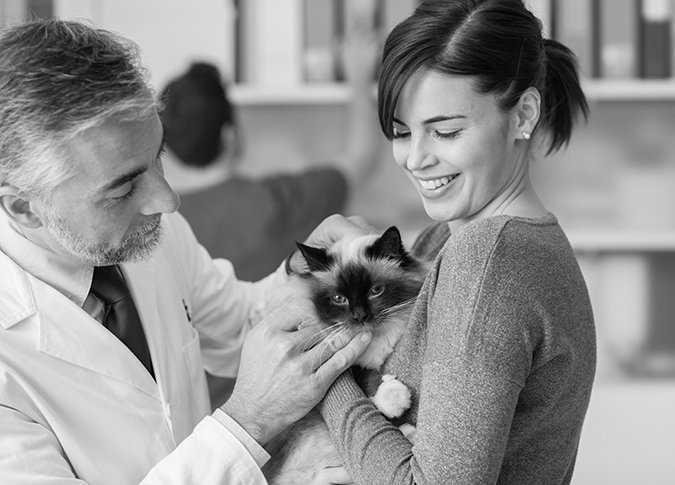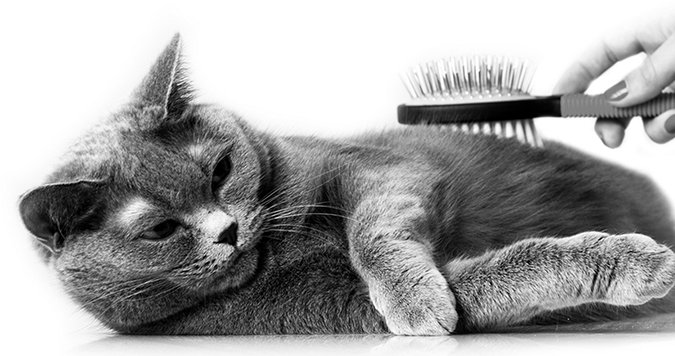Thanks to medical advances and improved nutrition, our cats are living longer than ever. However, longer life increases the likelihood of age-related diseases, including cancer. The Animal Cancer Foundation estimates that 6 million cats are diagnosed with cancer annually. They present a challenge to owners and veterinarians to provide the best quality of life with a minimum of pain.
While cancer doesn’t appear to be as prevalent in cats as in dogs, the disease is generally more aggressive in them. Compounding the difficulty is the fact that fewer cats, compared to dogs, get routine veterinary care. Veterinary oncologists in specialty and teaching hospitals and private practice use treatments similar to those used in people, including surgery, chemotherapy and radiation therapy. The goal for both veterinarians and owners is to minimize side effects and discomfort.
© dolgachov | Bigstock

6 Simple Strategies to Increase Comfort
Recognizing and alleviating pain, whether from cancer, another disease or an underlying condition is foremost in maintaining quality of life for your cat. Actions can vary from medical intervention to providing comfort. Owners can make accommodations from simple home modifications to complementary therapies provided either in a clinic setting or at home. Among the experts’ recommendations:
1. Complementary therapies — They include acupuncture, massage, and laser and physical therapy. Some practitioners make house calls. Some veterinary colleges, including Cornell, have rehabilitation services.
2. Heated beds — Well-padded beds, with or without heating, help ease pain and enable better rest since patients may sleep more soundly. Heated beds may help ease joint pain for those with arthritis.
3. Pet stairs or ramps — These can reduce the stress on joints from jumping up on the bed, sofa or chair. Ramps are the gentler, less impactful choice for elderly, arthritic or disabled pets.
4. Food, water — Make palatable foods available; this may mean adding flavor enhancers such as chicken broth, tuna juice and baby food. Always have fresh water available. Place these resources, including a litter box, nearby so the pet doesn’t have to use extra energy to reach them.
5. Hygiene — Grooming will be difficult for some cats and they will need your help. Gently wash fur, face and genitals with a soft cloth. Brushing and combing also may be necessary. Our animal companions do not often lose their hair like people undergoing cancer therapy. They may experience hair thinning, loss of whiskers, and if they have a shaved area, the hair usually will not grow back until after treatment is completed.
6. Social time — Provide cats with attention, affection and perhaps special treats from family members. Remember to handle pets gently as some conditions and handling create pain.
© stokkete | Bigstock

Devoted to Care
Meeting this goal demands a high degree of partnership among specialists and their staffs, and for owners a deep commitment to their at-home patients. Caring for a cat with cancer is a team effort.
Veterinarians stand ready with individualized help. “Since we often know what side effects a typical course of chemotherapy may produce, we start our patients on appetite stimulants, anti-nausea, antidiarrheal and pain medications to help prevent and alleviate these undesirable reactions,” says Leni Kaplan, DVM, MS, a lecturer in the Community Practice Service at Cornell University College of Veterinary Medicine.
“Veterinarians and their staff will educate owners and provide tips and tricks to get the medications into their pets. Owners are taught how to administer fluids at home or use a feeding tube if that is necessary for the treatment and care of their pet.”
Licensed veterinary technician Laura Barlow works closely with owners at the Cornell University Hospital for Animals’ Oncology Service. “When we talk about animal companions, we are trying to achieve the best quality of life for the longest possible time. We use treatments that have been shown effective for particular types of cancer and have been shown to be tolerated well in a majority of the population with minimal amount of side effects.”
Because there are so many types of cancer, each responding to different types of treatment or combination of treatments, and each cancer patient responds differently, there is no No. 1 side effect, Barlow says. “Each chemotherapy agent is different, but the most common side effects can be GI signs such as vomiting, diarrhea, nausea, anorexia and bone marrow suppression.”
Some Mild Signs
The resulting low white-blood cell count can make it more difficult for a patient to fight off infection. “We will tailor protocols and treatment regimens if needed to reduce the amount of side effects or avoid them altogether,” Barlow says. “Many of our patients tend not to experience side effects or have very mild symptoms, but occasionally some will experience one or all symptoms and in some cases even need hospitalization for supportive care.”
These are some of the areas where oncologists and owners can work together for the patient.
© dadoodas | Bigstock

Improving Nutrition
Loss of appetite is a common side effect of chemotherapy and occurs for a variety of reasons, including nausea, disinterest, flavor changes as a result of treatment or associating food with a negative experience, says Barlow. Proper nutrition is paramount to maintain strength, maximize treatment and improve survival time.
“Stimulating appetite may be as simple as warming the food or adding flavor enhancers such as chicken broth, or crumbled bleu cheese to food. Yes, it’s smelly but it sometimes stimulates the appetite,” says Joseph Wakshlag, DVM, Ph.D., ACVN, Associate Professor of Nutrition at Cornell. “If food enhancements don’t encourage eating, we use appetite stimulants. Mirtazapine is used for both dogs and cats, and cats particularly respond better to this medication.”
Dr. Kaplan suggests feeding pets several smaller meals a day versus the usual two to three larger meals and offering human food such as pasta, chicken, turkey or baby food to stimulate the appetite.
Avoiding Discomfort
Pain recognition and management are imperative for cancer patients, Barlow says. “For cancer patients, pain management includes medications (oral, liquid or patch that the owner may administer at home), physical rehabilitation therapy, nerve blocks or acupuncture.”
Dr. Wakshlag says it’s easier for us to recognize pain in our dogs because we engage more robustly with them and see changes in activity. We don’t see pain in our cats unless we really engage them in play. “Our cats sit in our laps. We pet them for a little while. You might bring the feather out for play, but a lot of elderly cats have gotten bored with that or they really don’t like it. So how do we actually look to detect pain in an older cat? That’s a very hard thing to do.”
Barlow reminds us that we should learn to recognize signs of pain in all our pets, not just cancer patients. “A pet’s reaction to pain can vary greatly dependent on the degree of pain and the pet’s temperament. Signs of pain can include trembling, shaking, panting, rising slowly, decreased appetite, behavior changes, difficulty sitting or lying down, bearing no weight or partial weight on a limb, change in energy level, hesitance to be touched in painful area and seeking out areas to be alone.”
Many cancer patients have many underlying conditions in addition to cancer, Dr. Wakshlag says. “They have cancer, cognitive decline, osteoarthritis, etc. It’s important to treat the whole animal. Most older pets have some form of joint discomfort. For example, over 50 percent of older cats have arthritic lesions with a lot of degeneration. We recommend glucosamine and chondroitin oral supplements. Some people like Adequan, an injectable, or fish oil to increase omega 3 intake.”
One caution: Some supplements can interfere with chemotherapy and/or radiation. Check with your cat’s veterinarian to make sure supplements won’t interfere with treatment.
Resting and Recovering
Lethargy and malaise may be common for some cats undergoing cancer treatment; however, let them engage their normal, routine activities if they feel up to it. If a cat doesn’t show interest in activities, provide time and a quiet space for him to rest. In some cases exercise restriction may be recommended.
While the cat is undergoing treatment, Dr. Kaplan says it’s important to make his life as stress free as possible. “For example, if having company or traveling is stressful for the pet, then ideally this would be postponed until after their chemotherapy is completed.”
Keep Communicating
The most important part of home cancer care is open, constant communication with the veterinarian. “If the pet is not eating, experiences vomiting or diarrhea, isn’t taking medication, shows signs of discomfort or changes in normal activities, it is not only imperative to report these things to the veterinarian, as they could signal something more serious, but veterinarians want to know how their patients are faring with their treatments,” Dr. Kaplan says.
Barlow sums it up: “You know your cat best so it is important to be an active participant in his care. Communication is key.”



